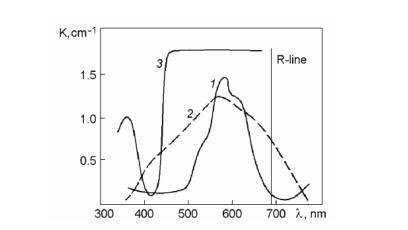Kunshan Shuojing Photoelectric Technology Co., LTD
Mr. Jiang:18261685858
Mr. Jiang:13482461082
Email:gingerjzj@163.com
Adress:Room 809, Building 2, Jiayu International Business Plaza, Zhoushi Town, Kunshan City
Web address:shuojingcrystal.com
Application of sapphire crystal in jewelry industry
Without going into detail about the traditional use of sapphire in the jewelry industry [1,2], let's just discuss ways to adapt the color of the crystal. Bright colors with attractive shades are produced by introducing some mixed components into the starting material for colored emery crystal growth (Appendix Table 1.8). However, the desired colors and shades are not always available.
The difficulty (enhancement and change of color) is the general procedure, as most natural crystals suffer from fading which reduces their value. Many centuries ago, Aristotle noticed the color-improving effect of ruby in an oxidizing medium. "The red color of this gem will become more beautiful if it is placed in a fire or in an ashes trough"[3]. In the Middle Ages, Birunee described a method of improving the color of gemstones by heating them slowly.
Today, most natural gemstones undergo a color beautification process that increases their value by 1-2 levels. Usually, the aesthetic improvement and decorative quality of gemstones are the result of the formation of the color center and the result of such supplementary processing that cannot be achieved for some reason under natural conditions. The color of sapphire can change either within the entire crystal or only on its surface. Crystals obtained from different depositions are known for variable impurity incorporation and special effects. Therefore, various methods of affecting crystals are used.
The most widely used means of changing crystal color are the following:
� Radiation
� Ion implantation
� Heat treatment in different gaseous media.
� Thermochemical treatment
In many cases, the best results can be obtained by using a combination of the above methods.
Irradiation with X-rays, cyclotrons, reactors and various other radiation methods changes the valence of impurities or deepens existing color centers or forms new ones. After irradiation, colorless and pink sapphires acquire an orange color. The method of irradiating ruby is not used, as this will worsen its color purity.
Implantation of colorless sapphire with a dose of 5 • 1016 to 5 • 1017 ions/cm2 and an energy of 20 keV resulted in a gray color. Then heated in air, the color changes from green (1,070 K, 3 h) to light blue (1,270 K, 3 h). The X‐ray and photoelectron spectra of cobalt also changed: the spectra of the non-annealed samples were almost identical to those of the pure metal. The spectrum of the annealed sample has two maxima corresponding to the 779 eV and 781.4 eV spectral bands. This fact indicates that in colored sapphire, two types of electronic configurations exist for cobalt.
Heat treatment in various gaseous media can change the valence state of impurities and thus change the color of crystals. For example, Al2O3:Ni crystals (yellow sapphire or "oriental topaz") can be reversed to obtain smoke shades depending on the annealing medium. The color of rubies becomes more intense as different valences of chromium are converted to trivalent chromium. Blue sapphire that is too dark can be brightened by heating until some of the titanium-iron complex breaks down. The color of speckled gemstones can be made more uniform through a diffusion process.
Thermochemical treatment changes the color of the crystal surface. The results of thermochemical treatment of pink sapphires and artificial colorless sapphires from Vietnam have been reported [4]. Pink sapphire (chromium content -0.01%) was heated in an atmosphere of saturated cobalt vapor at 1,270-1,470 K. The absorption spectrum of the obtained sample was compared with that of natural sapphire in the visible range. The interaction between aluminum and cobalt oxide at 1,670 K was investigated [5]. CoAl2O4 compound spinel is disclosed. The width of the solid solution zone is almost independent of temperature. A comparison of the absorption spectra of the blue noble family with that of natural sapphire (Fig. 1.1) confirms that the maximum values of the absorption bands of the two objects are consistent.
Noble sapphires have a dull pinkish hue, typical of Sri Lankan natural sapphires, due to the appearance of narrow resonant R-lines in the spectrum. Such a feature is inherent in the crystal, and the absorption maximum optical density is lower than 1‐1.5 cm‐1 . The absorption band of CoAl2O4 spinel grown by Weiner law is in the short wavelength region of the spectrum, and the crystal is violet. Experiments have shown that obtaining colored crystals is expensive because it can resist any light, temperature, and radiation that occurs in nature.

Absorption spectra of high-precious Vietnamese sapphire (1), natural sapphire (2), and cobalt-aluminum spinel (3).
The combined use of different methods implies changes in the valence of chromium atoms or their localization in the corundum structure, as well as their constituent diffusion distributions as the foreign phase dissolves. For example, conditions under which different factors positively affect sapphire (0.01-0.15% Ti and 0.03-0.6% Fe) have been reported: heating to 1,770-1,870 K in a vacuum furnace, isothermal annealing and rapid cooling for 24-30 hours [6] ]. The samples of the outer grade obtained transparency and blue color. Irradiation with gamma rays at a dose of 2 •106 rads stimulated some samples to obtain a dark amber effect and in other instances attenuated dark blue brightness.
Kunshan Shuojing Optoelectronics Technology Co., Ltd. is involved in a wide range of new materials, and has complete preparation methods and means for functional ceramics and sapphire crystals, scintillation crystals, and laser crystals, forming optically transparent ceramics, sapphire optical windows, scintillation crystals, lasers and nonlinear crystals The main four series of high-tech products.